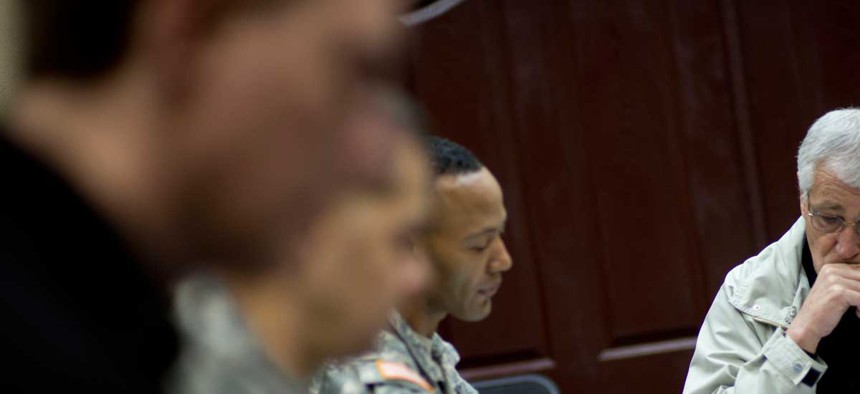
DOD Photo by Erin A. Kirk-Cuomo
So When Does the U.S. Really Need Afghanistan to Sign the Troop Deal?
Obama administration officials still want a troop deal in Afghanistan in place by the end of the year, but want and need are two different things. By Stephanie Gaskell
After saying earlier this week in Afghanistan that a U.S. troop deal would have to be in place by February’s NATO meeting of defense ministers, Defense Secretary Chuck Hagel appeared to be giving Afghan President Hamid Karzai a little wiggle room.
But Hagel, back in Washington on Thursday, said he was misunderstood and repeated his desire for Karzai to sign an agreement by the end of the year. Still, Hagel pointed to February’s meeting as the next critical moment for NATO’s post-2014 ability to maintain a presence in Afghanistan. One day earlier, however, a White House spokesman said it, too, wants a deal by New Year’s Day but conceded Karzai would “probably not” cause the U.S. much difficulty for post-2014 planning if the deal came later.
So when does the U.S. really need a bilateral security agreement signed?
For weeks, U.S. officials have insisted Karzai sign by Dec. 31 the bilateral security agreement approved by U.S. and Afghan negotiators. If not, Hagel has threatened to have the Pentagon begin planning for a full withdrawal of U.S. troops by the end of 2014.
White House spokesman Josh Earnest said on Wednesday that the agreement “should be signed as soon as possible, and that at the very least it should be signed by the end of this year in order for us to start going through the important planning process.”
But Earnest then added: “Now, if you're asking me, does that mean that if they sign it on January 10th, that's going to be a huge problem -- probably not. What will be a significant problem is if there is not quick action taken to get this signed.”
In Thursday’s Pentagon press conference, Hagel said that a U.S. deal must be inked by the end of the year so that the NATO-led coalition of about 50 allies likely to participate to post-2014 Afghanistan could review the plan at the February meeting.
“They too have to plan. They too have to budget. They too have political constituencies. They too have parliaments they have to work through. And what I said was our partners are going to want some clarity, some signal from the United States, where we are,” Hagel said.
“This is not an easy or uncomplicated process. If you just look at our military and what we have to do in order to plan and prepare for a post-2014 mission – train, assist, advise, counterterrorism, numbers of troops, where would they be, budgets, the Congress. This is complicated. Then you factor in all of our partners, that adds further complication and the BSA is just the beginning of that.”
“I wasn’t setting a deadline for anything, I was just giving a fact of life that when we all meet, our ISAF partners, the defense ministers meet at that NATO defense ministerial at the end of February, that we’re going to have to have some clarity and not just for us but our partners are going to expect that,” Hagel argued.
Karzai’s office says they would like U.S. and NATO troops to stay, but there is no reason for him to rush to sign. Karzai already sent the deal to a loya jirga meeting of Afghan elders who also approved it last month. Now, Karzai has suggested that he wait until April’s national elections to allow a new Afghan president to ratify the deal. But he has also placed new demands on the rules for U.S. raids on Afghan homes.
(Read More: Karzai Says There is ‘No Deadline’ to Sign Troop Deal)
Joint Chiefs Chairman Gen. Martin Dempsey, in Afghanistan this week, insisted that the negotiations are over and again said the option of a total U.S. troop withdrawal is possible. “First of all I am still not planning for a zero option, although I do consider it to be an unfortunate possibility given the current impasse at achieving the bilateral security agreement,” Dempsey said Wednesday. “So we are not planning a zero option although we clearly understand it could be a possibility.”
But retired Marine Gen. John R. Allen, former top commander of the international coalition in Afghanistan, appeared to tear apart the Obama administration’s public strategy by detailing how the Pentagon could plan for the future while giving Karzai wiggle room – until April, even -- to sign the deal.
“The United States can ride this one out. And given the enduring American strategic interests in this part of the world, as well as our huge sacrifice, that’s exactly what we should do,” said Allen, now a fellow at the Brookings Institution, a in Nov. 28 New York Times op-ed co-written with Brookings’ Director of Research Michael O’Hanlon.
“The United States should stay patient. It can say to Mr. Karzai, If you want to reinforce Afghan democracy by letting your successor sign this security deal, we can live with that; in the meantime, working with your ministers and other leaders, we will plan on staying — precisely as if the accord were already in place. Of course, the United States can make contingency plans; it would need a Plan B in any event. Even as it anticipates alternate scenarios, it can continue discussions with Mr. Karzai on the other “conditions” that he has just introduced. For American leaders, we counsel patience and flexibility in the talks on a security deal,” they said.
Amb. James Dobbins, President Obama’s special representative for Afghanistan and Pakistan, also agreed that there is more time. “We haven’t at this point set a date beyond which we’re no longer prepared to wait,” he said, in testimony before the House Foreign Affairs Committee this week.
The standoff by now has invoked comparisons to negotiations for keeping U.S. troops in Iraq, which went down to the wire. It wasn’t until Oct. 21, 2011 – just months before the planned year-end withdrawal – that President Obama announced there was no deal. Roughly 40,000 U.S. troops left Iraq within two months.





